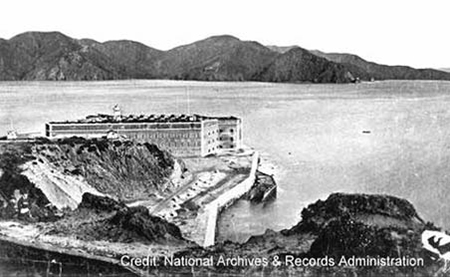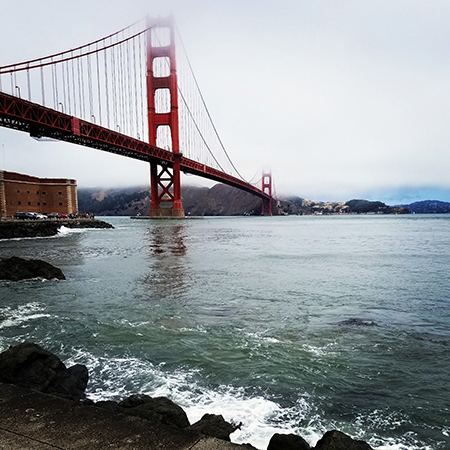The Pacific Squadron of Imperial Russian Navy at San Francisco in 1863
There is sort of an obscure historical Marin fact that relates to the Civil war. A Russian squadron sailed into the SF Bay in the early 1860s and ended up staying against Tzarist official order as sort of a back up to the meager US fleet that was concerned about both French and English ships that might have sided with the south. One of the squadrons ran aground somewhere around 10 Mile Beach and the crew ended up walking out to the SF Bay to be rescued. ://www.ijnhonline.org/…/book-review-friends-in-peace…/
Sources: C. Douglas Kroll, ″Friends in Peace and War″ The Russian Navy′s Landmark Visit to Civil War San Francisco, Potomac Books, 2005. xii & 288 pp. endnotes, bibliography, index.
Review by Andrew Lambert
King′s College London

The arrival of the Imperial Russian Navy′s Pacific squadron at San Francisco in July 1863, where it remained for a year, has been interpreted in several distinctly different ways. While the relationship between the United States and Tsarist Russia might, at first glance, seem to be unusual, linking a democratic republic with a repressive autocratic empire, there were deeper reasons for this odd partnership. Both states were vast, truly continental landmasses with a taste for conquest, seizing large swaths of territory from Mexico and China. In both states land hunger and ever expanding frontiers were linked to religious faith and cultural identity. In the 1860s both states faced a crisis of secession, the Southern Confederacy in 1861 and the Polish uprising in 1863. Both states contained large slave populations, the Russian serf had no more freedom than a field slave in the southern states of America. These synergistic factors far outweighed any ideological divisions.
Critically both states feared the global reach and economic power of Britain, and the cutting edge of that power, the Royal Navy. In 1812 – 1814 America felt the hard hand of British economic warfare; the Russians had learnt the lesson more recently, in the Crimean War of 1854-56. In that conflict Americans supported Russia, supplying arms and intelligence, even offering to operate privateers. After the Crimea American entrepreneurs like Samuel Colt and shipbuilder William H Webb were quick to profit from the Russian re-armament programme. This was a partnership built on self-interest, and shared hatred.
When the Civil War broke out Russia, ideologically averse to internal unrest rejected French calls to join a European diplomatic intervention. In 1863 the Federal Government repaid the compliment by backing Russia against a Polish national uprising, while Britain and France protested. The fact that both powers faced dangerous internal divisions and external pressure from London and Paris generated a geo-strategic partnership.
In the Crimean War the Russian Fleet, unable to get to sea from the Baltic and the Black Sea, had been effectively useless. Learning the lesson the Russians sent their Baltic and Pacific squadrons to America in 1863, in case the Polish Revolt turned into a second Crimean War, in part because the Americans had already offered them access to repair facilities at New York and San Francisco. San Francisco was a key Federal position, during the war $173 million worth of gold passed through the port, shipped to the east by steamer. The Confederates, well aware of these shipments, attempted to seize one of these ships. The presence of Southern sympathisers made the city nervous, and it was not very well defended. Fort Point, now under the southern end of Golden Gate Bridge, was newly completed, but not especially powerful. Without a linked battery on the north shore it was easily avoided. Alcatraz was rather stronger, but did not receive ship-killing 15 inch Rodman guns until 1864. The American Pacific Squadron comprised a few steamers and sailing ships. The monitor Camanche sent out in sections sank to the bottom of the harbour before being unloaded. Although raised she only entered service when the threat had passed. Consequently the arrival of a powerful Russian squadron that offered to defend the port against a Confederate (and perhaps a British) attack was most welcome. That said the Russians Novik was wrecked at Point Reyes, but five more ships arrived, and stayed for a year. Russian sailors helped put out a fire in the city, and spent a lot of money locally, on repairs at Mare Island Navy Yard, supplies and coal, before staging a grand ball. In addition local merchants hoped to secure access to the expanding Russian market in the newly conquered Chinese territory in the Amur River delta, site of modern Vladivostock. Once the Russians had completed their repairs, and the Polish Revolt was over, Admiral Popov departed, the last ship left in August 1864.
This is an excellent case study of diplomatic and strategic interaction, with a strong local resonance. There are a few minor inaccuracies, the Russian flagship Bogatyr, a steam screw corvette, carried 17 guns not the 48 she is credited with on page 70, while Tsar Alexander did not mediate the War of 1812, His offer was firmly rebuffed by the British – at that time their allies against Napoleon.
